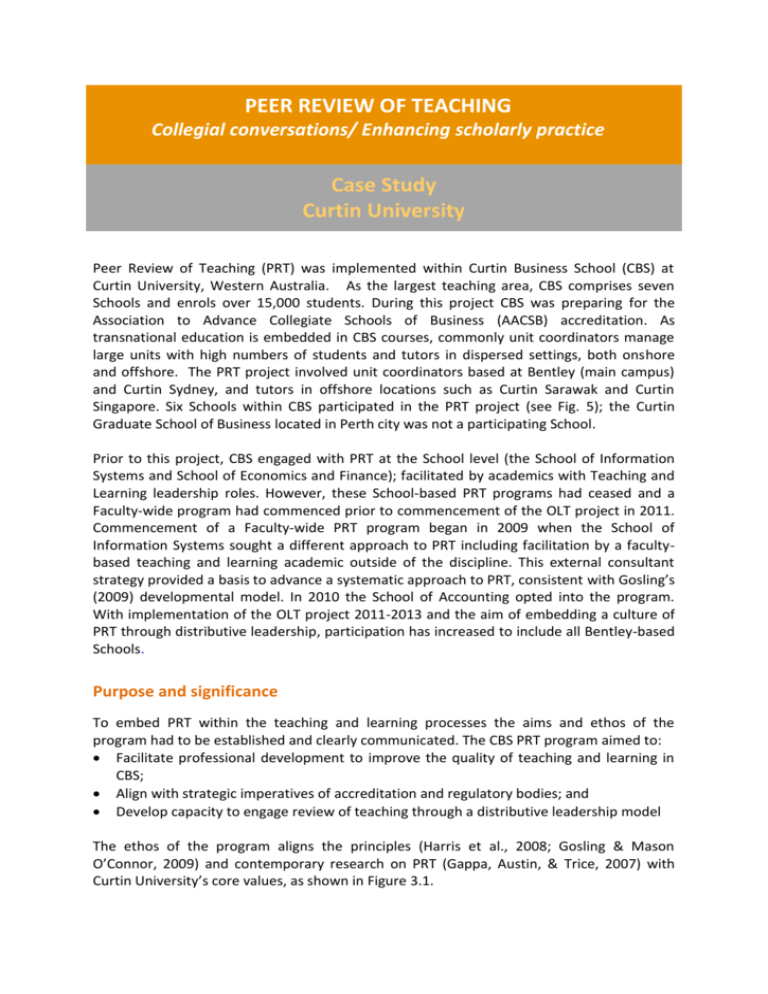Case Study: Curtin University
advertisement

PEER REVIEW OF TEACHING Collegial conversations/ Enhancing scholarly practice Case Study Curtin University Peer Review of Teaching (PRT) was implemented within Curtin Business School (CBS) at Curtin University, Western Australia. As the largest teaching area, CBS comprises seven Schools and enrols over 15,000 students. During this project CBS was preparing for the Association to Advance Collegiate Schools of Business (AACSB) accreditation. As transnational education is embedded in CBS courses, commonly unit coordinators manage large units with high numbers of students and tutors in dispersed settings, both onshore and offshore. The PRT project involved unit coordinators based at Bentley (main campus) and Curtin Sydney, and tutors in offshore locations such as Curtin Sarawak and Curtin Singapore. Six Schools within CBS participated in the PRT project (see Fig. 5); the Curtin Graduate School of Business located in Perth city was not a participating School. Prior to this project, CBS engaged with PRT at the School level (the School of Information Systems and School of Economics and Finance); facilitated by academics with Teaching and Learning leadership roles. However, these School-based PRT programs had ceased and a Faculty-wide program had commenced prior to commencement of the OLT project in 2011. Commencement of a Faculty-wide PRT program began in 2009 when the School of Information Systems sought a different approach to PRT including facilitation by a facultybased teaching and learning academic outside of the discipline. This external consultant strategy provided a basis to advance a systematic approach to PRT, consistent with Gosling’s (2009) developmental model. In 2010 the School of Accounting opted into the program. With implementation of the OLT project 2011-2013 and the aim of embedding a culture of PRT through distributive leadership, participation has increased to include all Bentley-based Schools. Purpose and significance To embed PRT within the teaching and learning processes the aims and ethos of the program had to be established and clearly communicated. The CBS PRT program aimed to: Facilitate professional development to improve the quality of teaching and learning in CBS; Align with strategic imperatives of accreditation and regulatory bodies; and Develop capacity to engage review of teaching through a distributive leadership model The ethos of the program aligns the principles (Harris et al., 2008; Gosling & Mason O’Connor, 2009) and contemporary research on PRT (Gappa, Austin, & Trice, 2007) with Curtin University’s core values, as shown in Figure 3.1. Figure 3.1: Ethos of the PRT program in CBS. Adapted from Gappa, J.M., Austin, A.E., & Trice, A.G. (2007). Rethinking Faculty Work: Higher Education's Strategic Imperative. San Francisco: Jossey-Bass. Essentially, the CBS PRT program supports professional growth through experiential and social learning conducted over three phases. In keeping with a developmental capacity building ethos participants experience PRT in Phase 1 by having their teaching observed, then reflecting on their own teaching prior to engaging in a collegiate conversation with the colleague who observed them to deepen reflection and assist action planning. At the end of each semester, participants within each School are encouraged, collaboratively, to reflect on their experiences of peer review of teaching in a group debriefing session. In Phase 2 participants are coached to act as observers, provide a supportive learning experience for participants and facilitate a quality assurance process within the program itself. This process enables immersion in a voluntary, constructive, developmental process. In Phase 3 participants are recognised for their participation in PRT and encouraged to continue engaging with the process within their Schools and across the Faculty. Figure 3.2: An experiential and social learning PRT process (CBS) Outcomes The ALTC/OLT project team developed a model for embedding peer review of teaching through cultural change (Figure 2.1). The CBS peer review process included opportunities for both individual and group reflection and allowed for coaching to enhance observational skills and was similar to the process identified in the centre of Figure 3.2. More broadly speaking, the CBS experience was consistent with other elements of the LeaD-IN model. For example, peer review across disciplines fits into Development. The resultant CBS networks have informed academics’ understanding of how to build on the kind of knowledge and learning experiences/skills that students gain from other units within the same major. It has also prompted discussions about how in general we can improve the student learning experience within the unit by knowing more about what we each do and therefore scaffolding knowledge and skills. Other outcomes described in this section include achievement of the aims of the PRT program, increased participation in PRT (see Table 3.6) and broader distribution of leadership (see Figure 3.3). Figure 3.3: Distributive Leadership Model of Peer Review of Teaching in CBS 2011-2013 Legend: : Green = 2011, Orange = 2012, Blue = 2013, Grey = PVC Factors enabling the peer review of teaching in CBS Leadership from executive (essential) Recognition of the role of PRT in teacher professional development Time allocation in Academic Workload Management System to allow staff to engage The dissemination of philosophy and aims of program throughout the Faculty at ‘town hall’ information sessions Making it clear to staff that the peer review of teaching in this case was for developmental purposes and not about performance management Voluntary nature of the program Having experienced and trained mentors to be involved from the outset Use of procedures, guidelines and supporting documents; see Appendices Ensuring that capacity was built up by a step-by-step approach (e.g. first being observed, then observing a colleague with support of mentor; then observing independently). Challenges to the peer review of teaching in CBS Overcoming a ‘natural’ resistance to having a peer observe your teaching. It was challenging for some observers to provide feedback to colleagues with similar amounts of teaching experience as themselves; or in positions of power, or with more teaching experience. University wide shift in emphasis to a research intensive university caused upheaval. Some found it challenging to see the relevance of teaching quality improvement when their student evaluation scores were above university average. With more reviewers and some line managers undertaking peer review it has been challenging to emphasise the developmental aspect of PRT rather than allowing managerial elements to take hold, eg requests for evidence that feedback has been reflected on and changes implemented. Entrenched beliefs about the way a discipline can be taught and the role of face to face teaching. Sessional staff often felt constrained by unit coordinator expectations. Consequently there was a reluctance to move away from what they believed Unit Coordinator’s wanted. To resolve this issue peer review champions need to work with Unit Coordinators to ensure there is a shared responsibility for guiding and developing sessional teaching staff. Time to engage. An inevitable evolution could occur as more people participate in peer review of teaching, more could be expected (by management) and people expected to participate in a review. It may even be that results of peer observations are expected to be communicated as part of, say, a promotions process. Other issues related to coordination and leadership, follow up, achievement of scale, a supportive policy environment, provision for casual teaching staff to participate and sustainability will need to be addressed. Now more than ever, with the emphasis on research outputs, teachers need to be able to collaborate and share in order to support each other in the changes to teaching in higher education and PRT needs to be harnessed to support quality teaching development. Advice for others In addition to any guidance that readers may have gleaned from reading this case study the following advice is offered: Ensure the PRT process is streamlined and targeted to what participants say they want. Time is the biggest challenge. The language of teaching is worth spending time on because with fluency comes a “short-hand” and shared understanding. Ensure there is some affirmation for the participant- for some people it is quite challenging to open up their paradoxically “private practice” of teaching to peer observation. Ensure that PRT retains very clear objectives which are not related to performance management or other objectives that may be pursued, from time to time. Future Plans The establishment of the Curtin Learning Institute and opportunity to attend the Peer Review of Teaching Symposium on 21 June 2013 have provided an excellent opportunity to promote and embed peer review of teaching across the University. However, with distributive leadership comes diversity of ownership and priorities. Accordingly, the different types of peer review of teaching (evaluative, developmental and collaborative) present challenges and tensions that cannot be ignored. Evidence has shown that the different types of peer review of teaching set within a supportive policy environment appear to exist simultaneously in some universities, albeit with distinct cultural differences evident in different countries (Times Higher Education-Top 100). Considering the different types of peer review of teaching and based on my experiences over the past few years with peer review of teaching in CBS, in alignment with the model, I offer the following recommendations for embedding a culture of peer review of teaching at Curtin University. Recommendations: 1. Embed a developmental approach to peer review of teaching 2. Integrate supportive policies and practices through communities of practice and champions 3. Provide leadership that articulates a clear vision and demonstrates respect for the shared responsibilities of staff development to meet individual and organisational needs Some strategies to achieve these recommendations include: 1. Development of University PRT guidelines and support strategies. 2. Recognition of PRT champions and teaching scholars within each Faculty. 3. Getting agreement and commitment from line managers to a 2-3yr plan for PRT. 4. Allocation of time for staff to undertake PRT. 5. Allowing staff to voluntarily participate on a rotational basis. 6. Coaching to accommodate views about “the way to teach”. 7. Professional development to enhance academics’ understanding of conceptions of and approaches to teaching in higher education.







